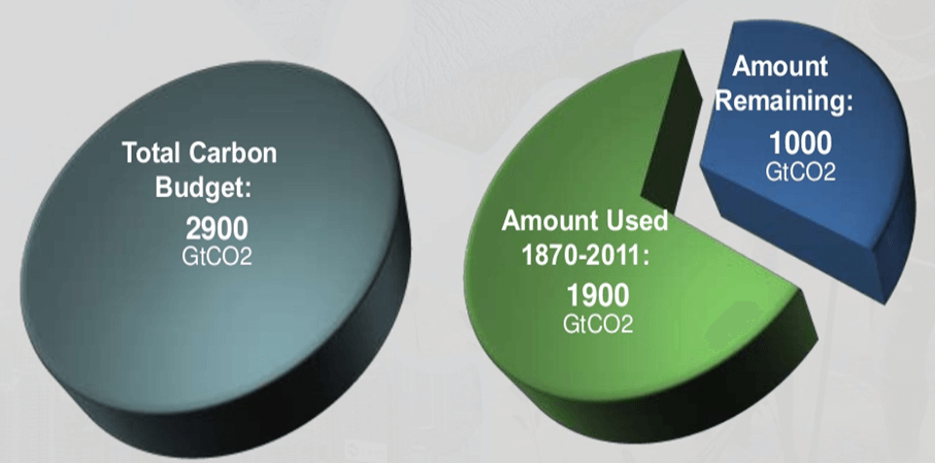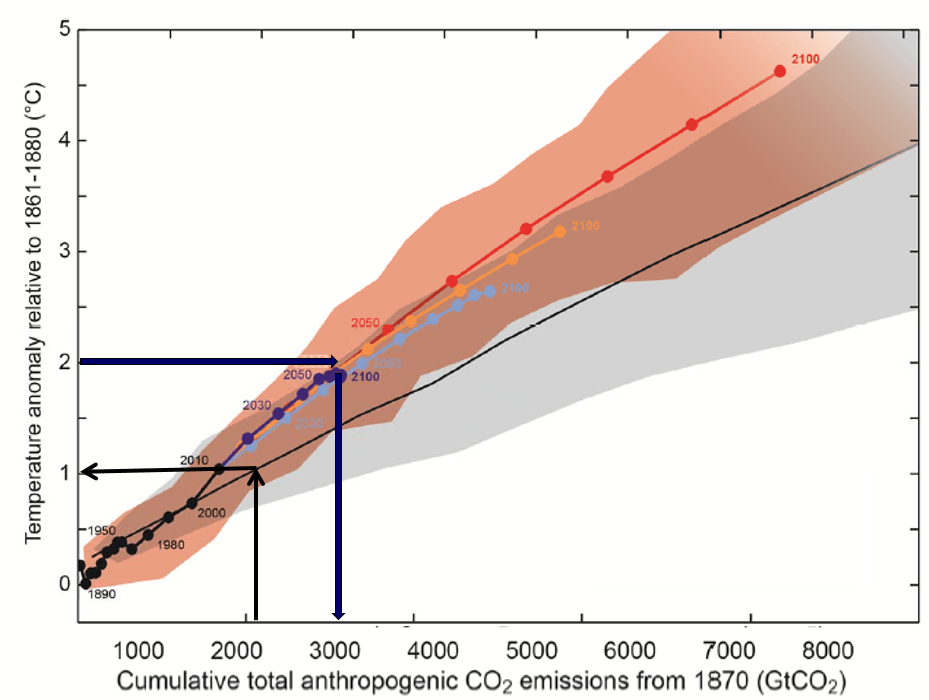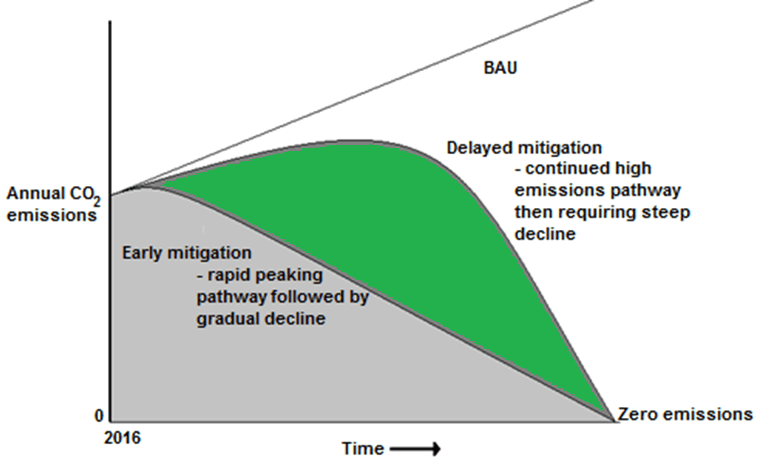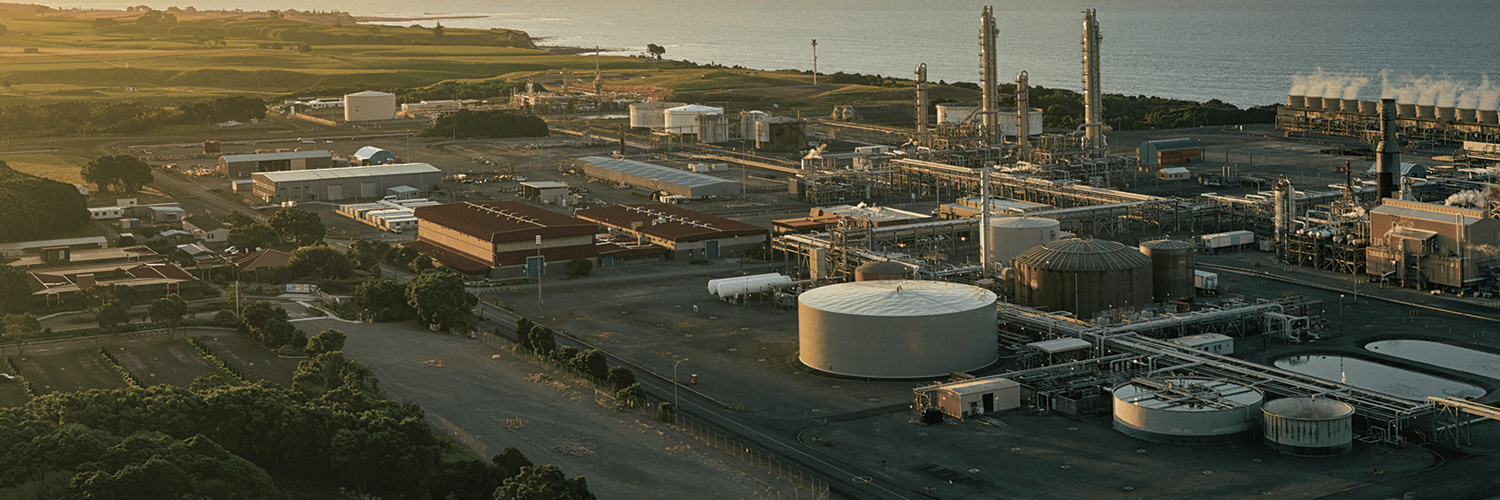Natural gas is claimed by the industry to be a “bridging fuel”, enabling the transition away from coal when moving towards the low-carbon economy of the future based mainly on renewable energy systems. In this expanded version of his recent op-ed Dr. Ralph Sims assesses whether we should be exploring for new natural gas resources with emphasis on the New Zealand situation. – ed
The carbon budget
Each carbon dioxide (CO2) molecule that is released into the atmosphere when combusting fossil fuels or cutting down and burning forests remains there for hundreds of years. Analysis by the Intergovernmental Panel on Climate Change has shown that if more than 2,900 billion tonnes of carbon dioxide (Gt CO2) are released into the atmosphere in total over past and future decades, then it is likely the planet will exceed the internationally agreed target of 2oC temperature rise above pre-industrial levels. (This assessment allowed for around 0.4oC warming of the 2oC coming from the non-CO2 greenhouse gases such as methane and nitrous oxide. Therefore, this article considers only CO2 emissions since these are long-lived and contribute around 80% of total warming).
Over 1,900 Gt CO2 have already been emitted since the late 19th century (Fig. 1). Presently, every year we are currently adding around 33 Gt CO2 from fossil fuel combustion plus approximately 5 Gt CO2 from deforestation and other land use change.
The atmospheric CO2 concentration level increases as emissions continue to accumulate. It has now reached over 403 parts per million (World Meteorological Organisation, 2017), the highest concentration for millions of years. As a result of this, as well as the other greenhouse gases and short-lived black carbon also forcing up the temperature, the planet is already around 1oC warmer than the average pre-industrial temperature of around 14.0oC that the world had enjoyed as a fairly stable situation for over 10,000 years and that made agriculture and civilisation possible.

Figure 1. The total carbon budget to avoid exceeding 2oC mean temperature rise (66% chance) with around two thirds of the budget from around 1870 used up to date. (IPCC, Working Group 1, 2013)
This fixed carbon budget implies that there is a limit to how much more CO2 can be released before we exceed the internationally agreed target of staying below 2oC temperature rise. Even staying below this level will result in drastic impacts of extreme weather events, water and food supply security issues, sea level rise etc. Future impacts are now inevitable so we will all need to learn how to adapt. At present we are continuing on a pathway to 3-4oC or even higher, leading to greater risks of biodiversity loss, freshwater scarcity, mass migration, conflict etc.
In the 6 years since 2011 (the year of the data shown in Fig. 1), we have released an additional 200 Gt CO2 to reach a total amount of the carbon budget now used of around 2,100 GtCO2 which has led to the present temperature rise of around 1oC (Fig. 2).

Figure 2. Cumulative emissions of carbon dioxide entering the atmosphere, with the historic pathway of emissions (black line with decadal dots starting from 1870) now reaching 2,100 Gt CO2 and resulting in a mean temperature anomaly of around 1oC. The four representative concentration pathways out to the year 2100 (red, orange, light blue and dark blue lines with shaded uncertainty ranges derived from IPCC models) confirm that the more CO2 that is released before 2100, then the warmer the planet will become. To stay below 2oC, the dark blue pathway confirms only around 2,900 Gt CO2 in total can be emitted. (IPCC, Working Group 1, 2013).
This means the amount of the budget “remaining”, with a 66% chance of staying below 2oC, is now down to approximately 800 Gt CO2 (Fig. 3). At the current business-as-usual rate of fossil fuel combustion and deforestation, the total budget will be exceeded within around 20 to 25 years. A steep decline in fossil fuel use from hereon will delay using up the total carbon budget over a longer period.

Figure 3. Continuing with business-as-usual emissions (red line) will exceed the carbon budget within around two decades and lead to a pathway heading towards 3-4oC temperature rise. To ensure we stay within the carbon budget and hence remain below 2oC, annual global emissions will need to peak in the next few years then decline rapidly to extend the budget into the second half of this century (yellow area). (Based on World Resources Institute Infographics).
(Based on World Resources Institute Infographics).
Once the carbon budget has been reached, around two-fifths of the known existing global reserves of coal, oil and natural gas will have been extracted, developed and consumed to provide heat, electricity and transport fuels, plus some used for manufacturing chemicals and plastics. Therefore, to avoid exceeding 2oC, the remaining three-fifths of fossil fuel reserves will need to stay in the ground. If we can somehow take carbon out of the atmosphere economically (e.g. by growing more forests, increasing the carbon content of soils, successfully employing carbon dioxide capture and storage (CCS) technologies, or figuring out other means of using the carbon), then potentially we could continue to use fossil fuels. However, for a range of reasons, none of these options are yet practical solutions, or available at sufficient scale to offset the current rate of emissions from fossil fuels. [not to mention the negative environmental and societal impacts associated with fossil fuels – ed].
So why do we continue to explore for even more oil and gas as well as open up new coal mines?
Gas as a transition fuel
Around the world, natural gas is claimed to be a ‘transition fuel’ that enables the use of coal to be reduced. This argument, and the case for providing greater energy security, is being used to justify exploration for deep sea oil and gas in New Zealand waters (PEPANZ, 2016).
What impacts might that have on the move towards a renewable energy future?
What would be the impacts on our greenhouse gas emission reduction targets if more gas was discovered and developed?
Displacing coal by burning conventional natural gas does produce lower emissions to provide the same heat or electricity services. For example, the UK has claimed a large share of its emissions reductions have come from moving away from coal-fired to gas-fired power plants. A coal-fired power station produces around 900-1100 g CO2/kWh generated; a gas-fired plant produces around 450-500 g CO2 /kWh. By way of comparison, a geothermal plant varies with the field but can emit up to 50 g CO2/kWh and emissions from other renewable energy plants vary widely with the circumstances but tend to be much lower. These figures vary with the efficiency of the plant, type of coal and its carbon content, and hence the CO2 produced per unit of energy. Natural gas is mainly CH4, hence its carbon content is less variable than coal.
However, on a life-cycle basis, any CO2 reduction benefits would be partially negated should there be any leakage to the atmosphere of methane (CH4), the main component of natural gas. The global warming potential of one molecule of methane, based on IPCC data, is about 25 times that of a molecule of CO2 when calculated over a period of 100 years. Leakage is inevitable during the extraction, distribution and use of natural gas. So the use of gas as a transition fuel to displace coal would certainly reduce CO2 emissions, but the degree to which this would be offset by CH4 leakage is difficult to determine without knowing the level of leakage. What can be stated with more certainty is that emissions from coal or gas plants, with or without leakage, are significantly higher than from a renewable energy plant of similar generation output.
The key point is that when conventional or unconventional natural gas is combusted, CO2 is still produced in relatively large quantities per unit of energy and the remaining global carbon budget is lowered as a result, even when displacing coal. Therefore, natural gas as a transition fuel has the potential to extend the time before the carbon budget is used up (assuming it displaces coal that would then be left in the ground) (Fig. 2) but the use of gas cannot deliver deep cuts in emissions as will be required to stay below 2oC.
Should carbon dioxide capture and storage (CCS) systems be commercially developed and deployed in the future, then more coal and gas could be consumed whilst staying within the carbon budget. However, although CCS is built into most climate models (often linked with bioenergy to remove carbon from the atmosphere), it is not yet a proven technology.
In New Zealand, natural gas is consumed for:
- electricity generation (around 13% of total generation in 2016),
- process heat for industries,
- conversion to methanol (mainly for export), and other petrochemical products such as urea, and
- to supply around 277,000 domestic, commercial, community and industrial consumers in the North Island through a distribution pipe network of over 20,000 km.
So the question is, if it becomes government policy not to develop any new fields, and no more natural gas is discovered and developed, what will happen once the 15 existing fields deplete and the 2000 PJ of existing reserves are consumed (in around 10 years’ time at current annual demand)?
- The electricity generation target of having 95% renewable generation by 2025 will easily be met given that over 2500 MW capacity of geothermal, wind and small hydro projects are already consented (the current total installed capacity in New Zealand is around 10,000 MW) and that solar PV capacity is also growing rapidly, but from a small base. Reaching 100% renewable electricity will be technically feasible, but to provide grid reliability, especially in dry-hydro periods, a back-up generation plant would be needed for the rare occasions that total demand cannot be met. This plant could be geothermal or fuelled by natural gas, stored biogas, or biomass (possibly in a modified existing coal plant) using stored wood chips. Regardless, the plant would need to be readily dispatchable to meet the fluctuating demand. Whatever the fuel type, a rarely used backup plant would not be a commercially viable investment, so would likely need to be owned, maintained and operated, under a government contract.
- Process heat, even at high-grade temperatures, can be provided by renewable resources including geothermal heat (where the demand is close to the fields), hydrogen produced from renewable energy (as is planned for a new Swedish steel plant), or biomass from forest or agricultural residues. Bioenergy is a mature technology, as used in Scandinavian countries where large scale combined heat and power (CHP) bioenergy plants (up to 400 MWel), have been operating for decades, as has the Kinleith pulp and paper mill CHP plant at Tokoroa.
- The Methanex Corporation mothballed its Motunui plant in 2004 when gas reserves were low but reopened it in 2009 once enough gas had been secured. It contributes around NZ$ 600 million to New Zealand’s GDP with 95% of its product exported to Asia. When gas becomes constrained in the future, it will have to close the plant again.
- The future of the Kapuni ammonia plant, where Ballance Agri-Nutrients produces the nitrogenous fertiliser urea, seems uncertain with the required NZ$ 1 billion upgrade further delayed by the company. Producing nitrogenous fertilisers is energy intensive so there is a global trend to find alternative lower carbon manufacturing processes, as well as resorting to legumes, such as clover, to provide soil nitrogen. This was the common practice for New Zealand pasture farmers before the urea plant was constructed in the 1980s.
- The existing grid infrastructure to distribute natural gas throughout the North Island has required a major investment of capital and should therefore be fully utilised. Over time, many of the present gas consumers will convert to electrical heating and cooking sources such as heat pumps and electro-thermal technologies. The future conversion of the gas grid to distribute hydrogen, produced using renewable energy resources, may be technically feasible once the natural gas supplies are diminished. Refer to the city of Leeds, UK which is in the process of converting it’s grid to hydrogen.
In summary, if no new gas resources are exploited in New Zealand, once the reserves from existing fields become depleted, alternative low-carbon sources of electricity, heat and nitrogenous fertilisers could be developed. Cost comparisons have not yet been undertaken, though any estimates would have to take into account the future price of carbon on gas supplies.
Energy security and fossil fuel subsidies
Many nations, including New Zealand, aim to improve their energy security by exploring for more indigenous fossil fuel resources in order to reduce their dependence on imports that are renowned for widely fluctuating prices. So exploring for more gas to meet local demands at contracted prices may make good political sense in the short term – but can only help to exacerbate the major climate problem that we all face in the longer term.
The world is dependent on fossil fuels, so it is difficult for any country, including New Zealand, to wean off their use and make the transition to low-carbon technologies (including renewables). Local and national governments realise there is political risk in being unable to meet immediate expectations from their citizens for mobility, cheap and reliable electricity, and heating/cooling services. In addition, fossil fuel exporting countries are unwilling to lose revenue by reducing exports, and multinational oil, gas and coal companies fear losing their economic dominance should demands for fossil fuels decline.
To add to the climate problems, fossil fuel exploration, extraction, production and consumption is widely subsidised by many governments. Where the International Energy Agency (IEA) definition of a subsidy is: Any government action that lowers the cost of energy production [that includes exploration], raises the price received by energy producers, or lowers the price paid by energy consumers. The IEA estimated the value of consumer subsidies in 2016 was over US$ 260 billion: US$ 107 billion for electricity (16% of global use), US$ 105 billion for oil consumption (11% of global demand), US$ 50 billion for natural gas subsidies (22% of global demand), and USD 2 billion for coal (IEA, World Energy Outlook, 2017). Estimating the level of supply subsidies by governments to encourage exploration and extraction of fossil fuels is more challenging.
For example, Australia currently produces around one third of global coal exports, and to continue this revenue stream, the Federal Government is supporting the opening up of new coal mines in Queensland, in association with the Indian corporate Adani, through funding coal transport infrastructure through the AU$ 5 billion Northern Australia Infrastructure Facility (NAIF). The four major Australian banks, however, are unwilling to co-finance this project due to the risks of coal becoming a stranded asset as well as the growing public resistance to its use.
Support for the oil and gas industry continues however, such as in Western Australia through the expansion of a port in the Pilbara where the Federal Government is supporting refueling and vessel loading facilities to improve the competitiveness of the offshore oil and gas industry in the region, that includes BHP and Chevron. In spite of strong opposition by environmentalists, an AU$ 16.8 million loan subsidy from NAIF has been awarded.
Conversely, divestment away from fossil fuel companies is growing worldwide. For example, New York City is not only intending to divest US$5 billion of its holdings away from fossil fuel assets, but is also planning to sue the major oil companies over their contribution to climate change. Many other examples exist to show divestment by institutions, particularly away from coal.
Under the banner “Friends of Fossil Fuel Subsidy Reform” (FFFSR), a small group of countries has been convened by New Zealand. They are aiming to reform their fossil fuel subsidies and influence other countries, but many economic, political and social barriers exist so little real progress has been made. A statement from 14 countries was presented by New Zealand to the 11th Ministerial Conference of the World Trade Organisation (WTO) in December 2017. As with the Communiqué from the FFFSR presented by Prime Minister John Key at the Paris COP 23 in 2015, it encouraged the impacts of inefficient fossil fuel subsidies to be addressed.
The question was then raised by environmental groups whether the New Zealand government provides fossil fuel subsidies. In 2013 an analysis by WWF (World Wildlife Fund) claimed the government was subsidising the local fossil fuel industry by NZ$ 46 million annually. An APEC review of subsidies in member countries in March 2015, found there were no “inefficient fossil fuel subsidies that lead to wasteful consumption” in New Zealand. The review examined motor spirit excise duty refund, funding of international treaty obligation to hold oil stocks, non-resident drilling rig and seismic ship tax exemption, indemnity for mining land remediation, research and development funding for the oil industry, tax deductions for petroleum-mining expenditures, financial restructure of Solid Energy, and the petroleum tax and royalty regime.
More recently, the “Fossil Fuels Aotearoa Research Network” reviewed and updated the WWF 2013 data. It estimated taxpayer subsidies to the oil and gas industry were NZ$ 88 million in 2016. They included pre-exploration activities, tax exemptions for drilling rigs and seismic ships, tax deductions for petroleum mining costs, geotechnical research provided free to the industry, and fuel price reductions for agriculture, forestry and fishing. No government statistics are available to confirm these estimates and the government has refused to reveal how much it provides in tax breaks for petroleum mining on the basis that it “no longer collects that information”.
In summary
There are two key questions for New Zealand to address.
- If more natural gas is discovered and exploited, and the international carbon price remains low, would the increased use of these additional supplies of cheap gas delay the rate of uptake of renewable energy systems? To reach the goal of achieving net zero emissions by later this century, ramping up the rate of development of renewables for electricity, heat and transport has to accelerate. Short-term cost savings from the increased use of new gas supplies would likely delay development of any more costly renewable energy projects, and also produce more greenhouse gases through delayed mitigation (Fig. 4). This would probably lead to overall greater costs of energy supply in the longer term.

Figure 4. The business-as-usual (BAU) trend of increasing annual CO2 emissions can either be rapidly reduced by taking early mitigation measures or more slowly by delaying mitigation. Either pathway can lead to reaching zero net emissions at a similar time somewhere in the future, but delaying actions will result in greater volumes of CO2 being emitted (as depicted by comparing the total area under delayed mitigation (green graph from 2016 onwards) with that of early mitigation (grey).
(Royal Society of New Zealand, 2016)
- If we find and exploit more gas for local use, how can we meet our nationally determined contribution (NDC) which, under the Paris Agreement, will need to grow more ambitious over time, and also achieve net zero emissions by 2050? Currently around 1,200,000 t/yr of coal are consumed in New Zealand mainly for heat and electricity, emitting around 2.6 Mt CO2 /yr. If all existing coal plants and heating systems were converted to gas, around 1.3 Mt CO2 /yr of emissions would be avoided. This would contribute a little towards the 20 Mt CO2-eq /yr of emissions reductions needed by 2030 to meet the current NDC target. However, given the Government’s target to reach net-zero emissions by mid-century, gas will ultimately need to be entirely phased out together with coal and oil products.
Therefore, the overall aims for New Zealand should be to:
- Use our existing reserves of natural gas wisely in order to gain maximum long-term economic benefits for the country by maximising the return on investments already made, as well as reducing our annual CO2 emissions by displacing coal and minimising methane leakage;
- Invest significantly in R&D in sustainable energy including developing low-carbon and economically viable alternatives for the current uses of existing gas supplies in anticipation of the existing gas reserves depleting;
- Clarify and quantify any fossil fuel producer and consumer subsidies that exist and remove them in the near future;
- Avoid the temptation to explore and develop new gas resources even if there may appear to be some short term economic benefits, though these would be largely offset by producing more CO2 emissions and, in the longer term, our international climate change commitments may well result in having to leave a portion of any newly discovered gas reserves undeveloped leading to stranded assets; and
- Invest in developing and deploying renewable energy technologies and systems when moving to the low-carbon economy of the future and becoming independent of fossil fuels.




Leave a comment